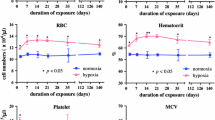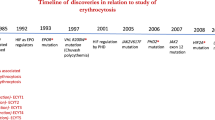Abstract
Mutations of the truncated cytoplasmic domain of human erythropoietin receptor (EPOR) result in gain-of-function of erythropoietin (EPO) signaling and a dominantly inherited polycythemia, primary familial and congenital polycythemia (PFCP). We interrogated the unexplained transient absence of perinatal polycythemia observed in PFCP patients using an animal model of PFCP to examine its erythropoiesis during embryonic, perinatal, and early postnatal periods. In this model, we replaced the murine EpoR gene (mEpoR) with the wild-type human EPOR (wtHEPOR) or mutant human EPOR gene (mtHEPOR) and previously reported that the gain-of-function mtHEPOR mice become polycythemic at 3~6 weeks of age, but not at birth, similar to the phenotype of PFCP patients. In contrast, wtHEPOR mice had sustained anemia. We report that the mtHEPOR fetuses are polycythemic, but their polycythemia is abrogated in the perinatal period and reappears again at 3 weeks after birth. mtHEPOR fetuses have a delayed switch from primitive to definitive erythropoiesis, augmented erythropoietin signaling, and prolonged Stat5 phosphorylation while the wtHEPOR fetuses are anemic. Our study demonstrates the in vivo effect of excessive EPO/EPOR signaling on developmental erythropoiesis switch and describes that fetal polycythemia in this PFCP model is followed by transient correction of polycythemia in perinatal life associated with low Epo levels and increased exposure of erythrocytes’ phosphatidylserine. We suggest that neocytolysis contributes to the observed perinatal correction of polycythemia in mtHEPOR newborns as embryos leaving the hypoxic uterus are exposed to normoxia at birth.
Key message
-
Human gain-of-function EPOR (mtHEPOR) causes fetal polycythemia in knock-in mice.
-
Wild-type human EPOR causes fetal anemia in knock-in mouse model.
-
mtHEPOR mice have delayed switch from primitive to definitive erythropoiesis.
-
Polycythemia of mtHEPOR mice is transiently corrected in perinatal life.
-
mtHEPOR newborns have low Epo and increased exposure of erythrocytes’ phosphatidylserine.







Similar content being viewed by others
References
Wu H, Liu X, Jaenisch R, Lodish HF (1995) Generation of committed erythroid BFU-E and CFU-E progenitors does not require erythropoietin or the erythropoietin receptor. Cell 83:59–67
Kralovics R, Prchal JT (2000) Congenital and inherited polycythemia. Curr Opin Pediatr 12:29–34
Lux CT, Yoshimoto M, McGrath K, Conway SJ, Palis J, Yoder MC (2008) All primitive and definitive hematopoietic progenitor cells emerging before E10 in the mouse embryo are products of the yolk sac. Blood 111:3435–3438
McGrath KE, Frame JM, Fromm GJ, Koniski AD, Kingsley PD, Little J, Bulger M, Palis J (2011) A transient definitive erythroid lineage with unique regulation of the β-globin locus in the mammalian embryo. Blood 117:4600–4608
Kingsley PD, Malik J, Emerson RL, Bushnell TP, McGrath KE, Bloedorn LA, Bulger M, Palis J (2006) “Maturational” globin switching in primary primitive erythroid cells. Blood 107:1665–1672
Divoky V, Liu Z, Ryan TM, Prchal JF, Townes TM, Prchal JT (2001) Mouse model of congenital polycythemia: homologous replacement of murine gene by mutant human erythropoietin receptor gene. Proc Natl Acad Sci U S A 98:986–991
Song J, Yoon D, Christensen RD, Horvathova M, Thiagarajan P, Prchal JT (2015) HIF-mediated increased ROS from reduced mitophagy and decreased catalase causes neocytolysis. J Mol Med (Berl) 93:857–866
Zhang J, Socolovsky M, Gross AW, Lodish HF (2003) Role of Ras signaling in erythroid differentiation of mouse fetal liver cells: functional analysis by a flow cytometry-based novel culture system. Blood 102:3938–3946
Yoon D, Watowich SS (2003) Hematopoietic cell survival signals are elicited through non-tyrosine-containing sequences in the membrane-proximal region of the erythropoietin receptor (EPOR) by a Stat5-dependent pathway. Exp Hematol 31:1310–1316
Pfaffl MW, Horgan GW, Dempfle L (2002) Relative expression software tool (REST) for group-wise comparison and statistical analysis of relative expression results in real-time PCR. Nucleic Acids Res 30:36
Lang KS, Roll B, Myssina S, Schittenhelm M, Scheel-Walter HG, Kanz L, Fritz J, Lang F, Huber SM, Wieder T (2002) Enhanced erythrocyte apoptosis in sickle cell anemia, thalassemia and glucose-6-phosphate dehydrogenase deficiency. Cell Physiol Biochem 12:365–372
Divoky V, Prchal JT (2002) Mouse surviving solely on human erythropoietin receptor (EpoR): model of human EpoR-linked disease. Blood 99:3873–3874
Rice L, Alfrey CP (2005) The negative regulation of red cell mass by neocytolysis: physiologic and pathophysiologic manifestations. Cell Physiol Biochem 15:245–250
Kingsley PD, Malik J, Fantauzzo KA, Palis J (2004) Yolk sac-derived primitive erythroblasts enucleate during mammalian embryogenesis. Blood 104:19–25
Malik J, Kim AR, Tyre KA, Cherukuri AR, Palis J (2013) Erythropoietin critically regulates murine and human primitive erythroblast survival and terminal maturation. Haematologica 98:1778–1787
Fraser ST, Isern J, Baron MH (2007) Maturation and enucleation of primitive erythroblasts during mouse embryogenesis is accompanied by changes in cell-surface antigen expression. Blood 109:343–352
Lin CS, Lim SK, D'Agati V, Costantini F (1996) Differential effects of an erythropoietin receptor gene disruption on primitive and definitive erythropoiesis. Genes Dev 10:154–164
Paffett-Lugassy N, Hsia N, Fraenkel PG, Paw B, Leshinsky I, Barut B, Bahary N, Caro J, Handin R, Zon LI (2007) Functional conservation of erythropoietin signaling in zebrafish. Blood 110:2718–2726
Ebie AZ, Fleming KG (2007) Dimerization of the erythropoietin receptor transmembrane domain in micelles. J Mol Biol 366:517–524
Halvorsen S, Bechensteen AG (2002) Physiology of erythropoietin during mammalian development. Acta Paediatr Suppl 91:17–26
Risso A, Ciana A, Achilli C, Minetti G (2014) Survival and senescence of human young red cells in vitro. Cell Physiol Biochem 34:1038–1049
Kuypers FA, de Jong K (2004) The role of phosphatidylserine in recognition and removal of erythrocytes. Cell Mol Biol (Noisy-le-Grand) 50:147–158
Risso A, Turello M, Biffoni F, Antonutto G (2007) Red blood cell senescence and neocytolysis in humans after high altitude acclimatization. Blood Cells Mol Dis 38:83–92
Risso A, Ciana A, Achilli C, Antonutto G, Minetti G (2014) Neocytolysis: none, one or many? A reappraisal and future perspectives. Front Physiol 14:54, eCollection
Acknowledgments
The study was supported by the VAH Merit Review Award (DY and JTP). VD and MH were supported by the Czech Science Foundation (project P301-12-1503) and by the European Commission (project CZ.1.07/2.3.00/20.0164). We thank Merav Socolovsky (University of Massachusetts), Paul Kingsley, and James Palis (Rochester University) for the helpful advice and Zuzana Korbasova (Palacky University) for the mouse genotyping.
Author information
Authors and Affiliations
Corresponding author
Ethics declarations
Conflict of interest
The authors declare that they have no competing interests.
Electronic supplementary material
Below is the link to the electronic supplementary material.
ESM 1
(PDF 211 kb).
Rights and permissions
About this article
Cite this article
Divoky, V., Song, J., Horvathova, M. et al. Delayed hemoglobin switching and perinatal neocytolysis in mice with gain-of-function erythropoietin receptor. J Mol Med 94, 597–608 (2016). https://doi.org/10.1007/s00109-015-1375-y
Received:
Revised:
Accepted:
Published:
Issue Date:
DOI: https://doi.org/10.1007/s00109-015-1375-y




